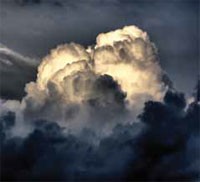Rain Rain Don't Go Away

By Valinda Huckabay
Rain patterns seem like a straightforward process -- water evaporates, is sucked into the atmosphere in large collections of water droplets called clouds and then falls back to the earth as rain. But what we're putting into the air may now be affecting the planet's ability to produce effective rain clouds.
Why Airborne Pollutants Matter
Based on what scientists from all over the world have been documenting for decades, the level of precipitation in some parts of the world has been consistently dropping. The normal process for creating rain-producing clouds has been hampered by the amount of man-made particulates being pumped into the atmosphere.
Particulates, called aerosols, are a mixture of solid particles and liquid droplets found in the air. Typically when particulates rise into the air, water vapor collects around them and they collide with each other, forming consistently larger droplets of water until they're heavy enough to fall out of a cloud as rain. With many of the man-made aerosols being released into the atmosphere (i.e., pollutants from sources such as power plants and gas-burning engines), the size of these particulates is too small to accumulate enough moisture to become heavy, so although the clouds form, they never produce rain.
How This Affects Climate
A link has now been established between large amounts of aerosols in the atmosphere and extreme weather: The clouds that form in drier regions may hold their moisture for a longer time or not release it at all, which contributes to reduced rainfall and droughts. Clouds that form over moister areas may release water too rapidly, causing severe rainstorms and flooding.
A study by Daniel Rosenfeld of the Hebrew University of Jerusalem, which uses satellite images to track airborne pollution streams coming from major urban areas and other sources, supports this theory. These pollution streams manifest as "dry" clouds that don't produce rain because they contain abnormally small water droplets.
In addition, tall, dense clouds formed by aerosol pollutants can also reflect sunlight back to space, causing a global cooling effect that may actually cancel out the warming effect of greenhouse gases, says Owen Toon, an atmospheric scientist at the University of Colorado at Boulder.
There is much debate about whether these studies are conclusive for the parts of the world that are affected by the recent, severe weather bouts. Hopefully research, not time, will tell.
Classroom Discussion
- How do you think this phenomenon will affect our planet's climate in the future?
- What do you think we can do to change this phenomenon?